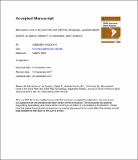Por favor, use este identificador para citar o enlazar a este item:
http://hdl.handle.net/10261/159268COMPARTIR / EXPORTAR:
 SHARE SHARE
 CORE
BASE CORE
BASE
|
|
| Visualizar otros formatos: MARC | Dublin Core | RDF | ORE | MODS | METS | DIDL | DATACITE | |

| Título: | Microseismic noise in the Saint Peter and Saint Paul Archipelago, equatorial Atlantic |
Autor: | de Queiroz, Daniel E.; Do Nascimento, Aderson Farias; Schimmel, Martin CSIC ORCID | Palabras clave: | Microseismic noise Primary microseisms Secondary microseisms Saint Peter and Saint Paul Archipelago Wind speed Significant wave height Atlantic Ocean |
Fecha de publicación: | dic-2017 | Editor: | Elsevier | Citación: | Journal of South American Earth Sciences, 80: 304-315 (2017) | Resumen: | Microseismic noise, also known as ambient seismic noise, are continuous vibrations mostly composed of Rayleigh waves pervasively recorded in the mili Hertz to 1 Hz frequency range. Their precise source mechanisms are under investigations and related to atmospheric perturbations and ocean gravity waves. Our purpose is to show the behavior of the microseismic noise recorded in the Saint Peter and Saint Paul Archipelago (SPSPA) with respect to wind intensity and ocean waves height in this region, between the North and South Atlantic Ocean. We have recorded both primary microseisms (PM) 0.04-0.12 Hz and the secondary microseisms (SM) 0.12-0.4 Hz during almost four years (2012-2015) and we used frequency, temporal, spatial and statistical correlation analysis to do qualitative and quantitative analysis with respect to wind speed intensity and significant wave height for the same periods. The results indicate a good correlation between the PM and the SM noise in the region particularly during the winter in the Northern Hemisphere and a poor correlation during the summer. We have also shown that probably most of the PM are generated in the SPSPA itself. We note that the intensity of SM recorded in SPSPA appears to have a seasonal behavior with the summer and winter in the Northern Hemisphere, and seems to influence the correlation between the PM and the SM, suggesting that the sources of the PM and the SM are not related to the same atmospheric event and from different places. PM generation would occur near the SPSPA whilst the SM would have distant sources towards the North Atlantic. (C) 2017 Elsevier Ltd. All rights reserved. | Versión del editor: | http://dx.doi.org/10.1016/j.jsames.2017.09.035 | URI: | http://hdl.handle.net/10261/159268 | DOI: | 10.1016/j.jsames.2017.09.035 | ISSN: | 0895-9811 | E-ISSN: | 1873-0647 |
| Aparece en las colecciones: | (Geo3Bcn) Artículos |
Ficheros en este ítem:
| Fichero | Descripción | Tamaño | Formato | |
|---|---|---|---|---|
| Schimmel_Journal_of_South_American_Earth_Sciences_80_304_preprint.pdf | 9,45 MB | Adobe PDF |  Visualizar/Abrir |
CORE Recommender
SCOPUSTM
Citations
2
checked on 21-abr-2024
WEB OF SCIENCETM
Citations
2
checked on 26-feb-2024
Page view(s)
242
checked on 24-abr-2024
Download(s)
301
checked on 24-abr-2024
Google ScholarTM
Check
Altmetric
Altmetric
NOTA: Los ítems de Digital.CSIC están protegidos por copyright, con todos los derechos reservados, a menos que se indique lo contrario.
